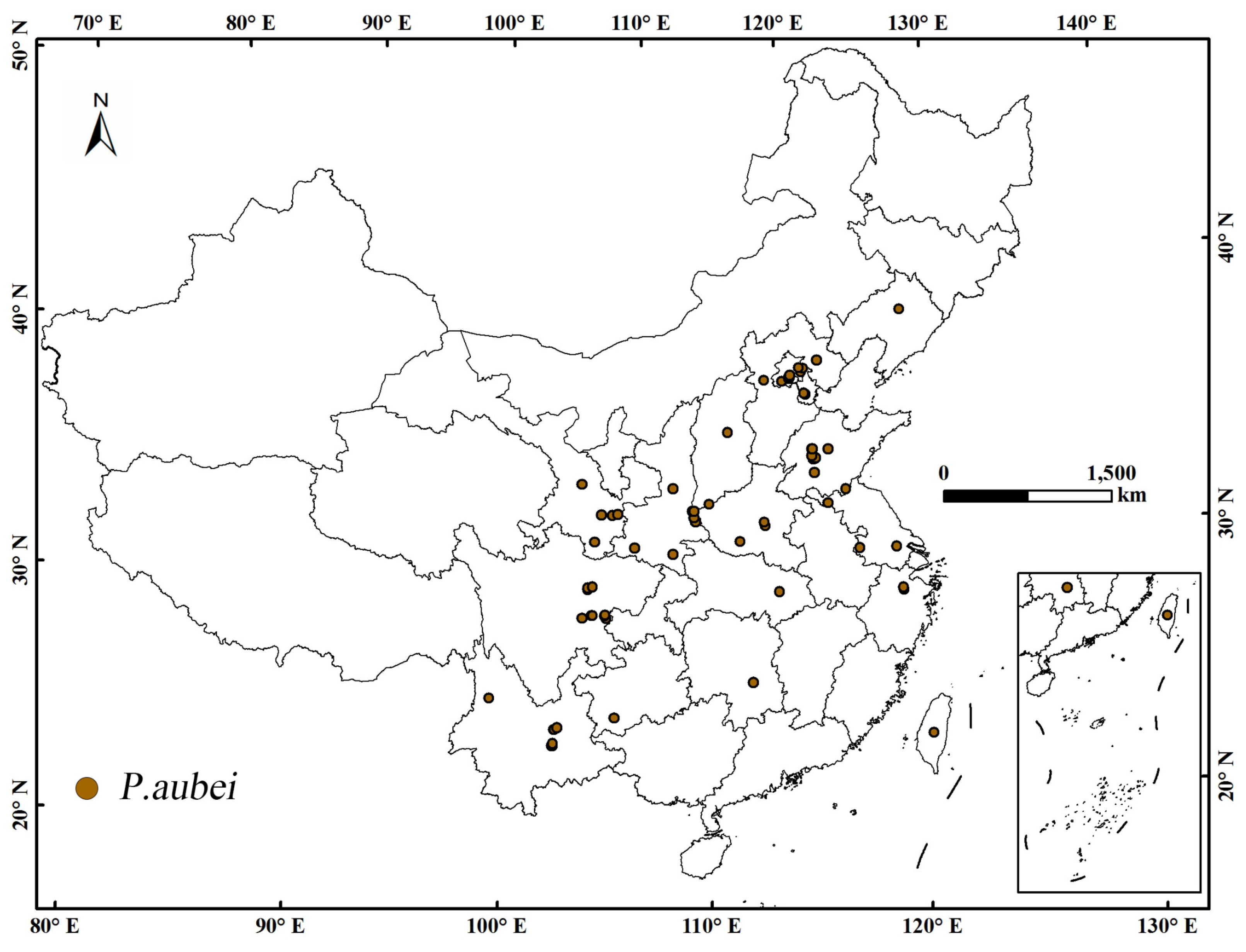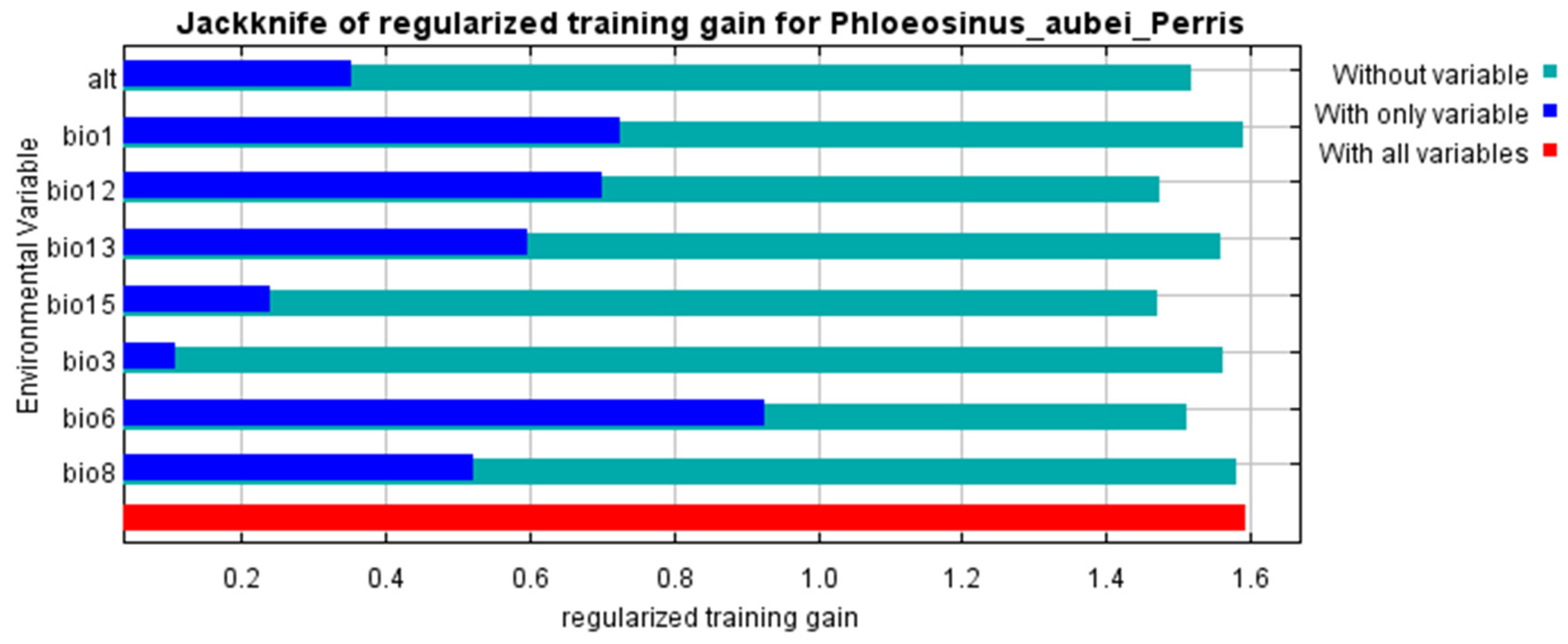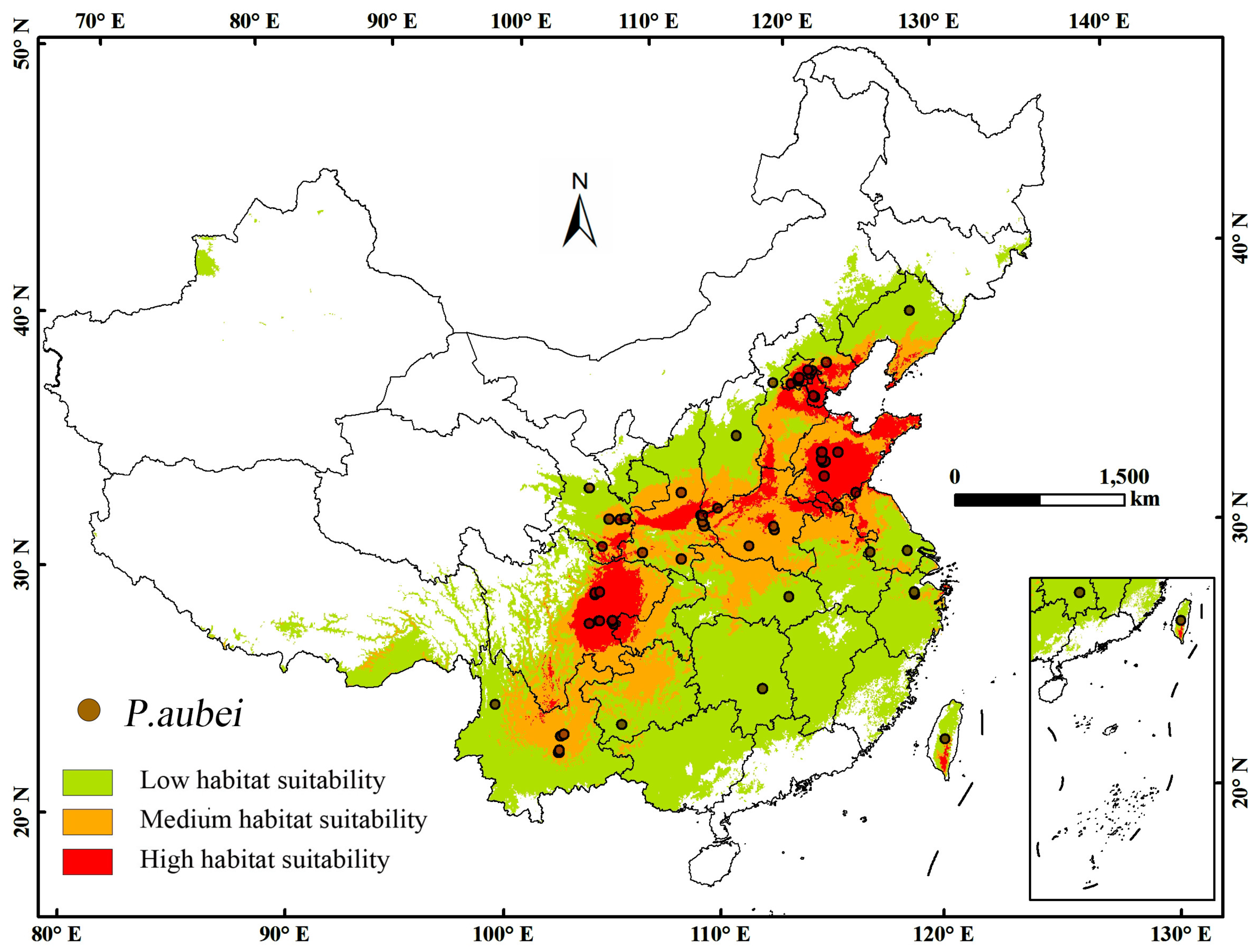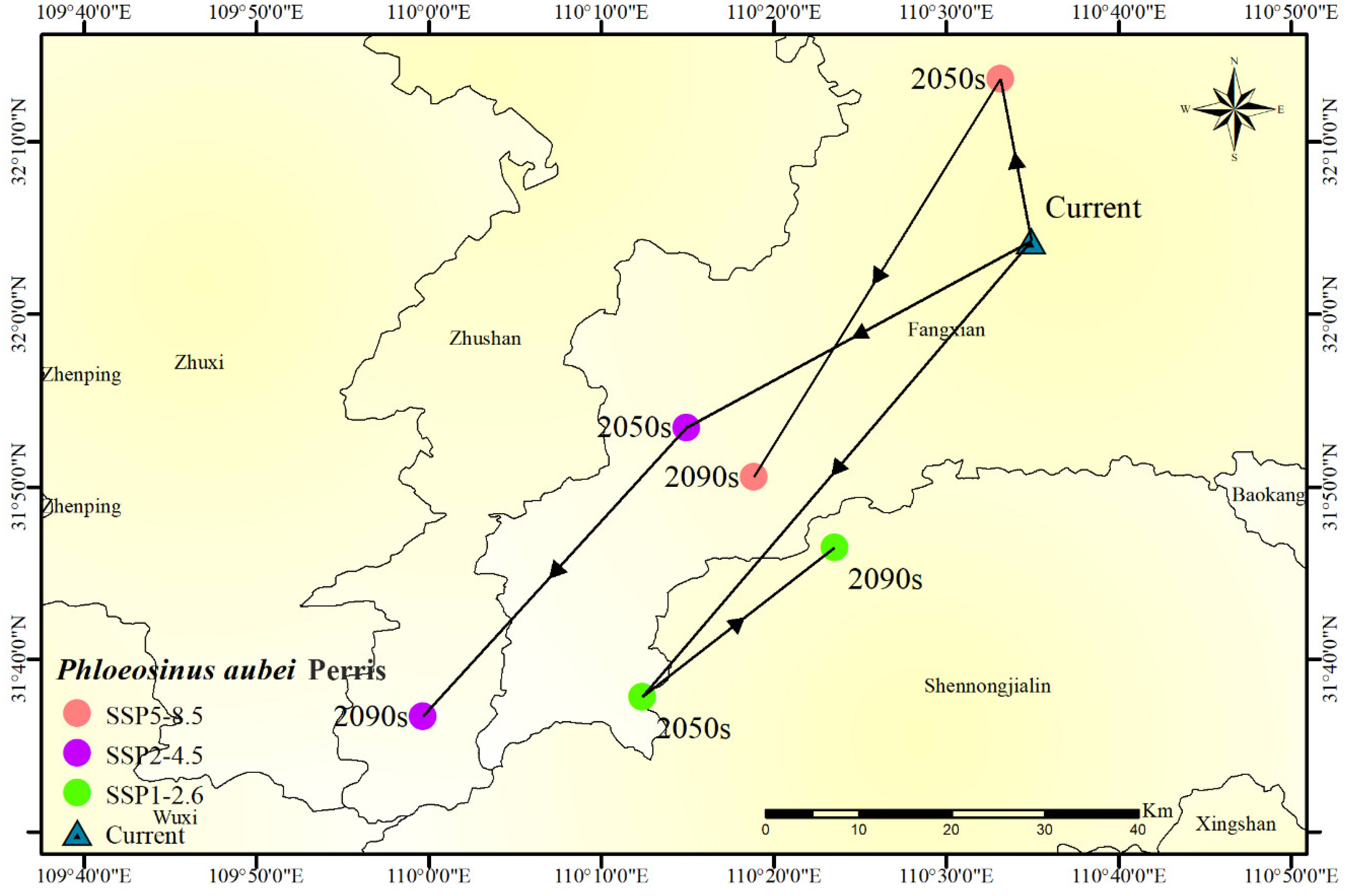Assessing Habitat Suitability for Phloeosinus aubei Perris in China: A MaxEnt-Based Predictive Analysis
Simple Summary
Abstract
1. Introduction
2. Materials and Methods
2.1. Species Occurrence Data and Bioclimatic Variables
2.2. Model Settings and Operation
2.3. Optimization of Model Parameters
2.4. Suitable Area Division and Model Accuracy Evaluation
3. Results
3.1. Key Climatic Drivers of P. aubei Habitat Suitability
3.2. The Effect of Temperature on Developmental Duration
3.3. Prediction of Potential Geographic Distribution of P. aubei Under Current Climatic Conditions
3.4. Potential Habitat Changes of P. aubei Under Future Climate Scenarios
3.5. Centroid Changes in Potential Distribution
4. Discussion
Challenges and Future Work
5. Conclusions
Author Contributions
Funding
Data Availability Statement
Conflicts of Interest
References
- Gábor, B.; Barta, M.P.; Móricz, A.; Szőcs, G. Changes to Volatile Profiles of Arborvitae, Thuja occidentalis, from Drought and Insect Infestation: Olfactory Cues for the Cypress Bark Beetle, Phloeosinus aubei. Chemoecology 2023, 33, 113–124. [Google Scholar]
- Yi, Z.; Deng, X.; Xue, W.; Chen, L.; Ou, S. Predicting Potential Suitable Habitats of Chinese Fir under Current and Future Climatic Scenarios Based on Maxent Model. Ecol. Inform. 2021, 64, 101393. [Google Scholar]
- Fiala, T.; Pyszko, P.; Holuša, J. Efficacy of Different Lures for Phloeosinus aubei and Other Native and Exotic Bark and Ambrosia Beetles. Ann. Appl. Biol. 2023, 184, 86–97. [Google Scholar] [CrossRef]
- Bozsik, G.; Molnár, B.P.; Szőcs, G. Changing Volatile Profile of Arborvitae, Thuja occidentalis, by Drying up and Infestation: Selective Olfactory Cues for the Cypress Bark Beetle, Phloeosinus aubei. Chemoecology 2023, 33, 1–16. [Google Scholar] [CrossRef]
- Remadevi, O.K. Status, Issues, and Challenges of Biodiversity: Forest Insects. In Forest Entomology and Protection; Springer: Singapore, 2022; pp. 325–362. [Google Scholar]
- Ning, H.; Deng, R.; Huang, B.; Xiao, K.; Huang, J.; Hong, J.; Yi, Y. Phloeosinus metasequoiae sp. nov. (Coleoptera, Curculionidae, Scolytinae, Phloeosinini), a New Insect Pest of Metasequoia glyptostroboides in China. ZooKeys 2025, 1228, 161–176. [Google Scholar] [CrossRef]
- Toccafondi, P.; Pennacchio, F.; Luongo, L.; Binazzi, F.; Garaguso, I.; Mercuri, I.; Vitale, S. Phloeosinus armatus Reitter (Coleoptera: Curculionidae: Scolytinae) and Its Associated Fungal Community Colonizing Cupressus sempervirens in Tuscany (Italy). Forest Pathol. 2025, 108, 71–81. [Google Scholar] [CrossRef]
- Mazur, A.; Witkowski, R. Notes on Distribution and Ecology of Phloeotribus caucasicus Reitter, 1891 (Coleoptera, Curculionidae, Scolytinae) in Europe. Sylwan 2025, 169, 112–119. [Google Scholar]
- Lissovsky, A.A.; Dudov, S.V. Species-Distribution Modeling: Advantages and Limitations of Its Application. 2. MaxEnt. Biol. Bull. Rev. 2021, 11, 265–275. [Google Scholar] [CrossRef]
- Li, Z.; Liu, Y.; Zeng, H. Application of the MaxEnt Model in Improving the Accuracy of Ecological Red Line Identification: A Case Study of Zhanjiang, China. Ecol. Indic. 2022, 137, 108767. [Google Scholar] [CrossRef]
- Wei, X.; Xu, D.; Liu, Q.; Wu, Y.; Zhuo, Z. Predicting the Potential Distribution Range of Batocera horsfieldi under CMIP6 Climate Change Using the MaxEnt Model. J. Econ. Entomol. 2024, 117, 187–198. [Google Scholar] [CrossRef]
- Zhang, Y.; Tang, J.; Ren, G.; Zhao, K.; Wang, X. Global Potential Distribution Prediction of Xanthium italicum Based on Maxent Model. Sci. Rep. 2021, 11, 16545. [Google Scholar] [CrossRef] [PubMed]
- Zheng, C.; Zhou, Q.; Wang, Z.; Wang, J. Behavioral Responses of Platycladus orientalis Plant Volatiles to Phloeosinus aubei by GC-MS and HS-GC-IMS for Discrimination of Different Invasive Severity. Anal. Bioanal. Chem. 2021, 413, 5789–5798. [Google Scholar] [CrossRef]
- Rathore, M.K.; Sharma, L.K. Efficacy of Species Distribution Models (SDMs) for Ecological Realms to Ascertain Biological Conservation and Practices. Biodivers. Conserv. 2023, 32, 3053–3087. [Google Scholar] [CrossRef]
- Gao, T.; Xu, Q.; Liu, Y.; Zhao, J.; Shi, J. Predicting the Potential Geographic Distribution of Sirex nitobei in China under Climate Change Using Maximum Entropy Model. Forests 2021, 12, 151. [Google Scholar] [CrossRef]
- Brown, J.L. SDMtoolbox: A Python-Based GIS Toolkit for Landscape Genetic, Biogeographic and Species Distribution Model Analyses. Methods Ecol. Evol. 2014, 5, 694–700. [Google Scholar] [CrossRef]
- Boria, R.A.; Olson, L.E.; Goodman, S.M.; Anderson, R.P. Spatial Filtering to Reduce Sampling Bias Can Improve the Performance of Ecological Niche Models. Ecol. Model. 2014, 275, 73–77. [Google Scholar] [CrossRef]
- Phillips, S.J.; Dudík, M.; Schapire, R.E. MaxEnt Software for Modeling Species Niches and Distributions (Version 3.4.4). Available online: https://biodiversityinformatics.amnh.org/open_source/maxent/ (accessed on 29 January 2024).
- Efron, B.; Tibshirani, R.J. An Introduction to the Bootstrap; Chapman & Hall/CRC: New York, NY, USA, 1993. [Google Scholar]
- Muscarella, R.; Galante, P.J.; Soley-Guardia, M.; Boria, R.A.; Kass, J.M.; Uriarte, M.; Anderson, R.P. ENMeval: An R package for conducting spatially independent evaluations and estimating optimal model complexity for MaxEnt ecological niche models. Methods Ecol. Evol. 2014, 5, 1198–1205. [Google Scholar] [CrossRef]
- Schnase, J.L.; Carroll, M.L.; Gill, R.L.; Tamkin, G.S.; Li, J.; Strong, S.L.; Maxwell, T.P.; Aronne, M.E.; Spradlin, C.S. Toward a Monte Carlo Approach to Selecting Climate Variables in MaxEnt. PLoS ONE 2021, 16, e0237208. [Google Scholar] [CrossRef]
- Dong, H.; Zhang, N.; Shen, S.; Zhu, S.; Fan, S.; Lu, Y. Effects of Climate Change on the Spatial Distribution of the Threatened Species Rhododendron purdomii in Qinling-Daba Mountains of Central China: Implications for Conservation. Sustainability 2023, 15, 3181. [Google Scholar] [CrossRef]
- Gao, R.; Liu, L.; Zhao, L.; Cui, S. Potentially Suitable Geographical Area for Monochamus alternatus under Current and Future Climatic Scenarios Based on Optimized MaxEnt Model. Insects 2023, 14, 182. [Google Scholar] [CrossRef]
- Foote, N.E.; Foote, G.G.; Comai, N.; Ibarra Caballero, J.R.; Stewart, J.E.; Ambrose, A.R.; Baxter, W.L.; Davis, T.S. Patterns of Occurrence, Phenology, and Phylogeny of Phloeosinus punctatus LeConte (Coleoptera: Curculionidae, Scolytinae) in Giant Sequoia. Environ. Entomol. 2024, 53, 1183–1196. [Google Scholar] [CrossRef] [PubMed]
- Nair, R.R.; Nakazawa, Y.; Peterson, A.T. An Evaluation of the Ecological Niche of Orf Virus (Poxviridae): Challenges of Distinguishing Broad Niches from No Niches. PLoS ONE 2024, 19, e0293312. [Google Scholar] [CrossRef]
- Wang, Y.; Ma, X.; Lu, Y.; Hu, X.; Lou, L.; Tong, Z.; Zhang, J. Assessing the Current Genetic Structure of 21 Remnant Populations and Predicting the Impacts of Climate Change on the Geographic Distribution of Phoebe sheareri in Southern China. Sci. Total Environ. 2022, 846, 157391. [Google Scholar] [CrossRef] [PubMed]
- Singh, H.; Kumar, N.; Singh, R.; Kumar, M. Assessing the Climate Change Impact on the Habitat Suitability of the Range-Restricted Bird Species (Catreus wallichii) in the Indian Himalayan Ecosystem. Environ. Sci. Pollut. Res. 2023, 30, 121224–121235. [Google Scholar] [CrossRef]
- Ruseva, S.; Todorov, I.; Pencheva, A. New Data on Ovalisia (Palmar) festiva (Linnaeus) (Coleoptera: Buprestidae) and Its Natural Enemies Reported from Bulgaria. Ecol. Montenegrina 2020, 28, 53–60. [Google Scholar] [CrossRef]
- Colwell, R.K.; Feeley, K.J. Still Little Evidence of Poleward Range Shifts in the Tropics, but Lowland Biotic Attrition May Be Underway. Biotropica 2025, 57, e13358. [Google Scholar] [CrossRef]
- Aguirre Ojeda, N.G. Bionomía de Phloeosinus deleoni Blackman (Curculionidae: Scolytinae) en el Estado de Nuevo León. Master’s Thesis, Universidad Autónoma de Nuevo León, Monterrey, Mexico, 2022. [Google Scholar]
- Cervantes-Espinoza, M.; Cuellar-Rodríguez, G.; Ruíz, E.A.; Atkinson, T.H.; Ochaeta, J.F.G.; Hernández-García, J.A.; Armendáriz-Toledano, F. Distribution of Phloeosinus tacubayae Hopkins, 1905 (Curculionidae, Scolytinae), the Cypress Bark Beetle, and New Records from Potential Distribution Models. Check List 2022, 18, 1165–1175. [Google Scholar] [CrossRef]
- Moraal, L.G. Infestations of the Cypress Bark Beetles Phloeosinus rudis, P. bicolor, and P. thujae in The Netherlands (Coleoptera: Curculionidae: Scolytinae). Entomol. Ber. 2010, 70, 140–145. [Google Scholar]
- Cervantes-Espinoza, M.; Ruiz, E.A.; Cuellar-Rodríguez, G.; Castro-Valderrama, U.; Armendáriz-Toledano, F. Immature Stages of Phloeosinus tacubayae (Curculionidae: Scolytinae): Morphology and Chaetotaxy of Larva and Pupa, Sexual Dimorphism of Adults, and Developmental Time. J. Insect Sci. 2023, 23, 23. [Google Scholar] [CrossRef]
- Şen, İ.; Sarıkaya, O. Maximum Entropy (MaxEnt) Modelling for Predicting the Potential Distribution of Phloeosinus aubei (Perris, 1855) as a Rising Threat for Cupressus sempervirens L. Trees in Turkey. Int. J. Ecosyst. Ecol. Sci. 2019, 9, 343–352. [Google Scholar]
- Wang, G.; Wang, C.; Guo, Z.; Dai, L.; Wu, Y.; Liu, H.; Li, Y.; Chen, H.; Zhang, Y.; Zhao, Y. Integrating MaxEnt Model and Landscape Ecology Theory for Studying Spatiotemporal Dynamics of Habitat: Suggestions for Conservation of Endangered Red-Crowned Crane. Ecol. Indic. 2020, 116, 106472. [Google Scholar] [CrossRef]
- Li, Y.; Li, M.; Li, C.; Liu, Z. Optimized MaxEnt Model Predictions of Climate Change Impacts on the Suitable Distribution of Cunninghamia lanceolata in China. Forests 2020, 11, 302. [Google Scholar] [CrossRef]
- Fitzgibbon, A.; Pisut, D.; Fleisher, D. Evaluation of Maximum Entropy (MaxEnt) Machine Learning Model to Assess Relationships Between Climate and Corn Suitability. Land 2022, 11, 1382. [Google Scholar] [CrossRef]
- Bukovsky, M.S.; Gao, J.; Mearns, L.O.; O’Neill, B.C. SSP-Based Land-Use Change Scenarios: A Critical Uncertainty in Future Regional Climate Change Projections. Earth’s Future 2021, 9, e2020EF001782. [Google Scholar] [CrossRef]
- Li, P.; Wei, Y.; Chen, G.; Sattar, A. An Analysis of Changes in Volatile Components in Walnut Fruits of Three Varieties after Infestation by the Codling Moth Based on HS-GC-MS and HS-GC-IMS. SSRN 2024. preprint. [Google Scholar] [CrossRef]
- Xu, Y.; Qiu, Z.; Zhang, Y.; Zheng, X.; Lu, W.; Hu, P. Volatiles from Eucalyptus Trunks and Forest Floor Humus Influence the Habitat Transfer, Host Selection, and Aggregation of Endoclita signifer Larvae. Forests 2022, 13, 2058. [Google Scholar] [CrossRef]
- Wang, Z.; Chen, W.; Gu, S.; Wang, J.; Wang, Y. Discrimination of Wood Borers Infested Platycladus orientalis Trunks Using Quartz Crystal Microbalance Gas Sensor Array. Sens. Actuators B Chem. 2020, 309, 127767. [Google Scholar] [CrossRef]
- Panzavolta, T.; Bracalini, M.; Benigno, A.; Moricca, S. Alien Invasive Pathogens and Pests Harming Trees, Forests, and Plantations: Pathways, Global Consequences and Management. Forests 2021, 12, 1364. [Google Scholar] [CrossRef]
- Bozsik, G.; Molnár, B.P.; Hegedüs, K.; Soós, T.; Schulz, S.; Tröger, A.; Francke, W.; Szőcs, G. Identification of Two Female Cypress Bark Beetle Pheromone Components and Evaluation of Their Activity in the Laboratory and the Field. J. Chem. Ecol. 2022, 48, 1230–1243. [Google Scholar]
- Pinnegar, J.K.; Hamon, K.G.; Kreiss, C.M.; Tabeau, A.; Rybicki, S.; Papathanasopoulou, E.; Engelhard, G.H.; Eddy, T.D.; Peck, M.A. Future Socio-Political Scenarios for Aquatic Resources in Europe: A Common Framework Based on Shared Socioeconomic Pathways (SSPs). Front. Mar. Sci. 2021, 7, 568219. [Google Scholar] [CrossRef]
- Chevallier, A.; Banton, E.; Moullec, F.; Morell, A.; Abello, C.; Pita-Vaca, I.; Peck, M.A.; Ernande, B.; Shin, Y. Participatory Downscaling of Global SSP–RCP Scenarios to Local Fisheries Social–Ecological Systems. Sustain. Sci. 2025, 20, 817–836. [Google Scholar] [CrossRef]
- Elith, J.; Kearney, M.; Phillips, S. The Art of Modelling Range-Shifting Species. Methods Ecol. Evol. 2010, 1, 330–342. [Google Scholar] [CrossRef]
- Karpun, N.N.; Petrov, A.V.; Zhuravleva, E.N.; Shoshina, E.I.; Kirichenko, N.I.; Mandelshtam, M.Y.; Musolin, D.L. Two Invasive Bark Beetles Phloeosinus armatus Reitter and Xylosandrus compactus (Eichhoff) (Coleoptera: Curculionidae: Scolytinae) Newly Recorded in Russia. EPPO Bull. 2024, 54, 166–181. [Google Scholar] [CrossRef]
- Ahmed, M.F.; Oyshee, A.A.N. Multi-Task Model with Attribute-Specific Heads for Person Re-Identification. Pattern Anal. Appl. 2025, 28, 38–55. [Google Scholar] [CrossRef]







| Abbreviation | Description | Percent Contribution | Permutation Importance |
|---|---|---|---|
| bio12 | Annual Precipitation (mm) | 30.4% | 27.3% |
| bio6 | Minimum Temperature of the Coldest Month (°C) | 29.0% | 22.8% |
| bio15 | Precipitation Seasonality (Coefficient of Variation) | 7.1% | 8.2% |
| bio8 | Mean Temperature of Wettest Quarter (°C) | 4.5% | 8.2% |
| bio3 | Isothermality (B102/B107) × 100 | 2.0% | 1.1% |
| bio13 | Precipitation of Wettest Month (mm) | 0.5% | 12.7% |
| bio1 | Annual Mean Temperature (°C) | 0.4% | 2.2% |
| alt | Altitude/Elevation | 0.1% | 2.8% |
| Scenarios | Decade | Total Suitable Regions | Regions of Low Habitat Suitability | Regions of Medium Habitat Suitability | Regions of High Habitat Suitability | ||||
|---|---|---|---|---|---|---|---|---|---|
| Area (104 km2) | Area Change (%) | Area (104 km2) | Area Change (%) | Area (104 km2) | Area Change (%) | Area (104 km2) | Area Change (%) | ||
| - | current | 331.97 | - | 203.78 | - | 91.31 | - | 36.88 | - |
| SSP1-2.6 | 2050s | 342.04 | 3.03% | 201.16 | −1.28% | 93.02 | 1.88% | 47.86 | 29.76% |
| 2090s | 341.60 | 2.90% | 194.24 | −4.68% | 100.42 | 9.98% | 46.94 | 27.28% | |
| SSP2-4.5 | 2050s | 333.54 | 0.47% | 194.75 | −4.43% | 87.08 | −4.64% | 51.72 | 40.23% |
| 2090s | 344.14 | 3.67% | 196.41 | −3.62% | 97.69 | 6.98% | 50.05 | 35.71% | |
| SSP5-8.5 | 2050s | 354.67 | 6.84% | 194.14 | −4.73% | 93.30 | 2.18% | 67.23 | 82.29% |
| 2090s | 344.20 | 3.68% | 199.52 | −2.09% | 91.50 | 0.21% | 53.17 | 44.18% | |
| Aspect | P. aubei | Similar Research | Key Differences |
|---|---|---|---|
| Key Environmental Variables | bio12 (precipitation: 30.4%) and bio6 (temperature: 29%) were most significant. | [30,31,32,33] Temperature and precipitation are consistently identified as critical for pest distribution. | Quantifies exact contributions (30.4% and 29%), while others discuss general trends without specific percentages. |
| Modeling Approach | MaxEnt was used with response curves and Jackknife tests to assess narrow tolerances. | [34,35,36,37] MaxEnt is widely applied, but (9) critiques its assumptions (e.g., unlimited dispersal). | Explicitly addresses P. aubei’s narrow tolerances, whereas (9) focuses on methodological limitations. |
| Future Projections (SSPs) | SSP5-8.5 predicts an 82.29% habitat suitability increase by the 2050s; a unique southwestward shift under high emissions. | [38,39,40] Northward shifts are common, but the IPCC notes regional variability. | Identifies a counterintuitive southwestward shift not highlighted in other pest studies. |
| Ecological Implications | P. aubei, as a secondary invader, exacerbates tree mortality in stressed forests. | [41,42,43] Bark beetles are generally linked to forest stress and economic losses. | Emphasizes P. aubei’s specific role in China while reviewing European outbreaks. |
| Management Strategies | Recommends early detection, public awareness, and adaptive management tied to SSPs. | [44,45] Supports rapid response and citizen science. | Integrates climate-specific adaptation (e.g., emission scenario-based strategies), unlike general focus. |
| Limitations | Notes MaxEnt’s neglect of dispersal barriers/host interactions and suggests incorporating land-use data. | [44,45] Critiques MaxEnt’s simplicity but proposes broader variable integration. | Links limitations to P. aubei’s dispersal ecology and provides generic recommendations. |
Disclaimer/Publisher’s Note: The statements, opinions and data contained in all publications are solely those of the individual author(s) and contributor(s) and not of MDPI and/or the editor(s). MDPI and/or the editor(s) disclaim responsibility for any injury to people or property resulting from any ideas, methods, instructions or products referred to in the content. |
© 2025 by the authors. Licensee MDPI, Basel, Switzerland. This article is an open access article distributed under the terms and conditions of the Creative Commons Attribution (CC BY) license (https://creativecommons.org/licenses/by/4.0/).
Share and Cite
Ahmad, S.; Xu, D.; Deng, X.; He, Z.; Ali, H.; Zhuo, Z. Assessing Habitat Suitability for Phloeosinus aubei Perris in China: A MaxEnt-Based Predictive Analysis. Insects 2025, 16, 576. https://doi.org/10.3390/insects16060576
Ahmad S, Xu D, Deng X, He Z, Ali H, Zhuo Z. Assessing Habitat Suitability for Phloeosinus aubei Perris in China: A MaxEnt-Based Predictive Analysis. Insects. 2025; 16(6):576. https://doi.org/10.3390/insects16060576
Chicago/Turabian StyleAhmad, Sabbir, Danping Xu, Xinqi Deng, Zhipeng He, Habib Ali, and Zhihang Zhuo. 2025. "Assessing Habitat Suitability for Phloeosinus aubei Perris in China: A MaxEnt-Based Predictive Analysis" Insects 16, no. 6: 576. https://doi.org/10.3390/insects16060576
APA StyleAhmad, S., Xu, D., Deng, X., He, Z., Ali, H., & Zhuo, Z. (2025). Assessing Habitat Suitability for Phloeosinus aubei Perris in China: A MaxEnt-Based Predictive Analysis. Insects, 16(6), 576. https://doi.org/10.3390/insects16060576








